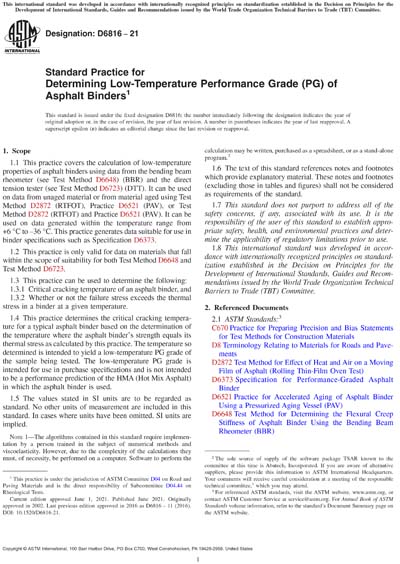Historical
ASTM D6816-21
Standard Practice for Determining Low-Temperature Performance Grade (PG) of Asphalt Binders
1.1This practice covers the calculation of low-temperature properties of asphalt binders using data from the bending beam rheometer (see Test Method D6648) (BBR) and the direct tension tester (see Test Method D6723) (DTT). It can be used on data from unaged material or from material aged using Test Method D2872 (RTFOT), Practice D6521 (PAV), or Test Method D2872 (RTFOT) and Practice D6521 (PAV). It can be used on data generated within the temperature range from +6 °C to "“36 °C. This practice generates data suitable for use in binder specifications such as Specification D6373.
1.2This practice is only valid for data on materials that fall within the scope of suitability for both Test Method D6648 and Test Method D6723.
1.3This practice can be used to determine the following:
1.3.1Critical cracking temperature of an asphalt binder, and
1.3.2Whether or not the failure stress exceeds the thermal stress in a binder at a given temperature.
1.4This practice determines the critical cracking temperature for a typical asphalt binder based on the determination of the temperature where the asphalt binder's strength equals its thermal stress as calculated by this practice. The temperature so determined is intended to yield a low-temperature PG grade of the sample being tested. The low-temperature PG grade is intended for use in purchase specifications and is not intended to be a performance prediction of the HMA (Hot Mix Asphalt) in which the asphalt binder is used.
1.5The values stated in SI units are to be regarded as standard. No other units of measurement are included in this standard. In cases where units have been omitted, SI units are implied.
Note 1:The algorithms contained in this standard require implementation by a person trained in the subject of numerical methods and viscoelasticity. However, due to the complexity of the calculations they must, of necessity, be performed on a computer. Software to perform the calculation may be written, purchased as a spreadsheet, or as a stand-alone program.2
1.6The text of this standard references notes and footnotes which provide explanatory material. These notes and footnotes (excluding those in tables and figures) shall not be considered as requirements of the standard.
1.7This standard does not purport to address all of the safety concerns, if any, associated with its use. It is the responsibility of the user of this standard to establish appropriate safety, health, and environmental practices and determine the applicability of regulatory limitations prior to use.
1.8This international standard was developed in accordance with internationally recognized principles on standardization established in the Decision on Principles for the Development of International Standards, Guides and Recommendations issued by the World Trade Organization Technical Barriers to Trade (TBT) Committee.
Content Provider
ASTM International [astm]






